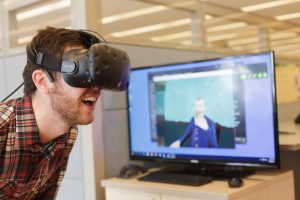Dream a Little Dream: Virtual Realities and Literature, taught by Nhora Serrano (Literature & Creative Writing) will introduce students to the representation of virtual worlds in literature, and how these ‘dreamscapes’ have transformed our understanding and experience of the “real.” Rooted in Borges and Cortázar and featuring authors such as L. Frank Baum, Lewis Carroll, and Murakami, students will use 3D technologies to imagine, design, and create virtual objects and environments based on the course readings. We anticipate a library research component to be embedded within this project.
As a Medieval specialist, Serrano is interested in exploring how virtual worlds are not a new concept, though the ways we explore them now are different. Serrano teaches about mimesis/representation and visuality, for course that engage the artificial and the real on different levels, from storyboarding to 3D technology like VR and 3D printing. To enhance their analytical skills, Serrano has her student engage with visual elements through creating; in this case, by creating a virtual environment students can better learn about the significance of virtual and “dream” worlds in the texts they read, through recreating them, gaining a better sense of what the virtuality of that world represents thematically within the text.
 The main assignment for the course will be to create a virtual moment from a book read in class (in groups of four or five students). Students will learn Unity to create a virtual environments that will be explorable with the HTC Vive connected to the zWorkstation and DreamColor display. Students will research and use found 3D models, and scan their own 3D models for use in this environment using the Sprout Pro and the HP Structured Light Scanner. As a scaffolded individual assignment in service of the final project, each student will select an object from a book read in class, and locate and 3D scan a real object that represents the book object (using the Sprout Pro or Structured Light Scanner). Students will have to justify the choice of object from the book and justify the choice of the real object used to represent it virtually.
The main assignment for the course will be to create a virtual moment from a book read in class (in groups of four or five students). Students will learn Unity to create a virtual environments that will be explorable with the HTC Vive connected to the zWorkstation and DreamColor display. Students will research and use found 3D models, and scan their own 3D models for use in this environment using the Sprout Pro and the HP Structured Light Scanner. As a scaffolded individual assignment in service of the final project, each student will select an object from a book read in class, and locate and 3D scan a real object that represents the book object (using the Sprout Pro or Structured Light Scanner). Students will have to justify the choice of object from the book and justify the choice of the real object used to represent it virtually.
Project Goals:
-
- Students will develop familiarity and interest with digital techniques for creative analysis and future use;
- Students will use simple 3D scanning to gain technological skills;
- Students will build team-working skills by creating a virtual environment in groups;
- Students will connect ideas about virtual/dream worlds from the text to our real(?) world;
- Students will evaluate various levels of representation and “the real” though texts, the worlds within text, and objects and virtuality in our own world.
Team
Faculty: Nhora Serrano
Instructional Designer and 3d Instructor: Ben Salzman
with support from Scott Paul and Digital Media Interns
